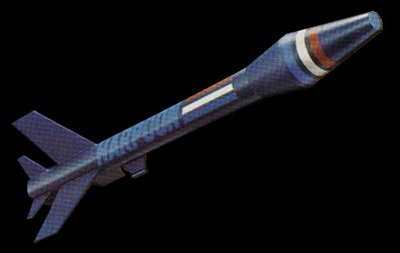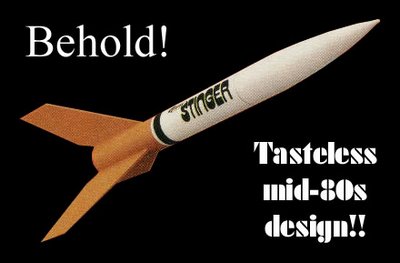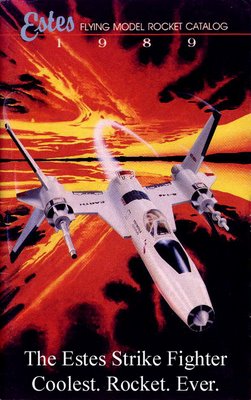My first fleet

When I was a kid, I was in 4-H. I learned all kinds of stuff in 4-H. Some of those things, like public speaking and basic photography, are central to the stuff I do now. Others, like horticulture and raising chickens, are on hold until we get to someplace with a yard (and tolerant neighbors). But those are all things I did through 4-H. They're not the reason I was in 4-H.
I was in 4-H for rockets.
I got my first rocket, an Estes Harpoon, when I was nine, the same year I got my first pocket knife. Harpoon had missile stylings and decals and would fly to about 500 feet. Dad built a launch system out of wire, alligator clips, and a doorbell buzzer. We would drive the pickup just a few hundred feet from the house to a grassy patch of unused land, hook up the launcher to the pickup battery, and launch it. It was the best thing ever.
Other rockets followed. My second was an Estes Magician, which flew to over 1000 feet on a D motor. Dad and I launched it in a pasture on a calm day. It may have been calm on the ground, but there was some serious wind blowing at 1000 feet, and after the rocket popped its parachute we chased it for more than a quarter mile. I did a science fair project on model rockets, comparing the performance of rockets with square, unsanded fins to those with fins that had been sanded into an airfoil shape and sealed with wood sealant. The sanded-and-sealed rockets flew twice as high as the rough ones. I tracked them with a homemade alititude tracker made from a protractor.

In 4-H, the rockets not only had to fly, they had to look spiffy, too. They were to be entered in the county fair and judged on appearance. So we spent a lot of time building them and putting on paint and decals. My cousin Michael introduced me to another school of rocketry, in which you built the thing in the morning, launched it in the afternoon whether the glue was dry or not, and painted it when and if it came back. I don't know that we ever permanently lost a rocket. Michael's Scout disappeared on us, but Michael found it floating in Uncle Robert's farm pond a while later. The fins had fallen off, but the fuselage and nose were intact. The next summer we taped up its ejection port, launched it at night, and watched it explode. It was awesome.
Hands down, our favorite rocket was the Estes Geo Sat LV. It was a scale model of a satellite launcher, loosely based on the Titan family, with a clear plastic payload section that contained a little satellite. It looked rad, and when it took off.... The Geo Sat was more than two feet tall, which was not enormous but still much bigger than any other rocket in Wedel experience. We were used to the Harpoon and Magician and Wizard, which just sorta vanished off the launch pad when you pressed the ignition button. Geo Sat lifted off slowly and majestically, with lots of fire and smoke and noise. It felt like launching a real rocket.

Here's a list of the rockets I built when I was a kid (i.e, between the ages of 9 and 16), in rough chronological order. All of them were Estes makes, because that's all I could find at the hobby store.
Harpoon
Magician
Wizard
Geo Sat LV
Space Shuttle
Eggspress
Strike Fighter
Dragonfly (boost glider)
Titan IIIE - never flown
Mini Mars Lander - never flown
SDI Satellite - never flown
The science fair fleet consisted of three rockets of the same make, whatever nFNC was cheapest at the time. I think they were Stingers.

I definitely joined the Estes Aerospace Club at one point and got a Viper out of it, but I honestly can't remember if I built it or not.
My brother Todd had a Tornado that he kitbashed into the extremely short, large-finned Nado. It was not stable, but the one flight was entertaining. Actually, I should do a whole post on Todd's um, interesting launches (and now I have). My Wizard pranged and crumpled the front of the body tube, so I chopped it down to an Izard.
Once in my late teens or early twenties my brothers and I bought Dad a Mean Machine. We launched that thing over and over.
Incidentally, all of these rockets are still in existence, propped against an usused wall in the upstairs bedroom that was mine and then my Todd's. I imagine that the rubber band shock cords and plastic parachutes could stand to be replaced after 15-20 years of inactivity, but the rockets are flyable. In fact, maybe we'll dust them off this Christmas and let them go.

All of the rocket images in this post started their digital careers on Sven Knudson's awesome, encyclopedic Ninfinger site. If you want to blow a few hours poring over old rocket catalogs, this is the place.

1 Comments:
Hey Matt - thanks for putting the Model Rocket Shop in your links. We love the GeoSat LV, too. We've got a couple left if you need one for "later" ;-)
Paul
Post a Comment
<< Home